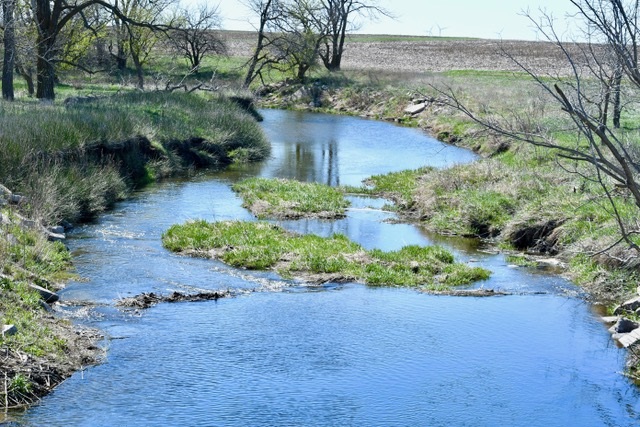The Raccoon River as it runs through Greene County should be properly identified as the North Raccoon River. In addition, there is a Middle, and South Raccoon River. The North Raccoon River originates near the town of Marathon in Buena Vista County, and it flows through Sac, Calhoun, Carroll, Greene, and Dallas Counties. It is a tributary of the Des Moines River, which in turn is a tributary of the Mississippi River.
The North Raccoon River is the longest of the three, measuring 196 miles. The location of the North Racoon River was first documented in 1814.
Since the 1800s the Des Moines metropolitan area has been obtaining its drinking water from the Raccoon River just before it empties into the Des Moines River.
Mr. G.S. (Gillum Solon) Toliver, who arrived in Greene County by covered wagon with his parents at the age of 8, in 1848, provides a description of the North Raccoon River in his diary. Excerpts from his diary (available for viewing at the Greene County Historical Society building) documents his recall of the river “…. The North Raccoon River was a clear rapid running stream when we first saw it, and its bottom was generally covered with white sand and gravel. No stock had crossed it. Nothing but the wild game had disturbed it. Frequently you could see a fish as far as across the river in two feet of water. The lands had not been plowed, so little of the soil reached the river to make the waters turbid and cover up the sand gravel and rocks on its bottom.”
While the river has changed dramatically in the past 176 years, nature-minded individuals monitor the quality of water. Observation and data collection helps identify changes or trends. Data can be used to identify where different practices should be implemented and if the practice change improves the outcome.
Bob Rye and several nature-minded colleagues from Greene and Polk County have been monitoring 46 public water sites in Greene County for the past two and half years. On a monthly basis they collect water from public drainage ditches, creeks, rivers, and ponds, observing for general appearance. They also observe and record stream bottom appearance, odor, algae color and texture, stream channel shade, stream bank composition and erosion, bank conditions, and water depth. Analysis is done for oxygen, pH, chloride, phosphate, nitrate, and temperature. Macroinvertebrates types and numbers such as dragonflies, crawdads, mayflies, and water penny beetles are also monitored. Collected data is submitted to the Izaak Walton League of America, Panora Chapter.

The land in Greene County is 85 percent cropland and has an average slope of 1.5 percent. This allows a gentle runoff, but Greene County houses almost 200,000 hogs, which contributes to an elevated nitrogen rate. In urban areas, it is easy to point to lawns and golf course fertilization as a culprit for elevated nitrogen, but for us in Greene County industrial agriculture greatly impacts water quality. Compared to urban streams in Polk County, Greene County’s spring nitrate is elevated, but chloride and phosphate are usually lower.
Bob Rye, a self-described naturalist and passionate environmentalist, grew up in Indiana, spending his summers in Michigan. He has always had a keen passion for water, enjoying and studying water and what grows in water. He was a teacher by educational preparation, but his most enjoyable position was serving for 22 years at the Springbrook State Park Conservation Education Center.
The importance of buffer strips at the water’s edge, cover crops to avoid winter soil erosion, an emphasis of deep-rooted grassland filters at creek and river edges is verbalized and strongly encouraged by Bob. He remorsefully discusses the dead zone in New Orleans, LA, because of stream pollution from the Mississippi River basin.
May 21 will be WATER QUALITY SNAPSHOT Day, when all counties along the Raccoon River watershed complete water testing. Safety considerations are always a part of the training, but consider this your opportunity to join in learning about water testing in Greene County. Junior high and high school students, and adults, have the potential to become a certified tester and to help Bob as he seeks to expand the testing sites into additional areas of Greene County.
Bob can be contacted at justrt@gmail.com.
VIEW FROM MY WINDOW is written by Mary Weaver, who resides on a farm near Rippey. She is planning to learn about water testing and be a part of SNAPSHOT DAY May 21.
